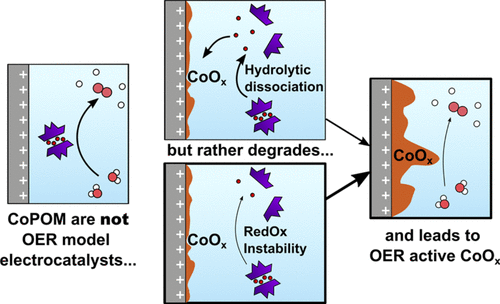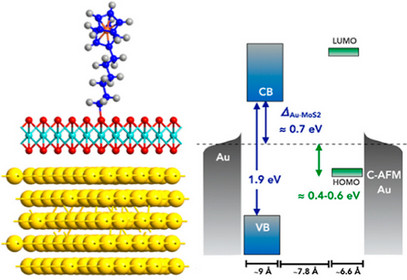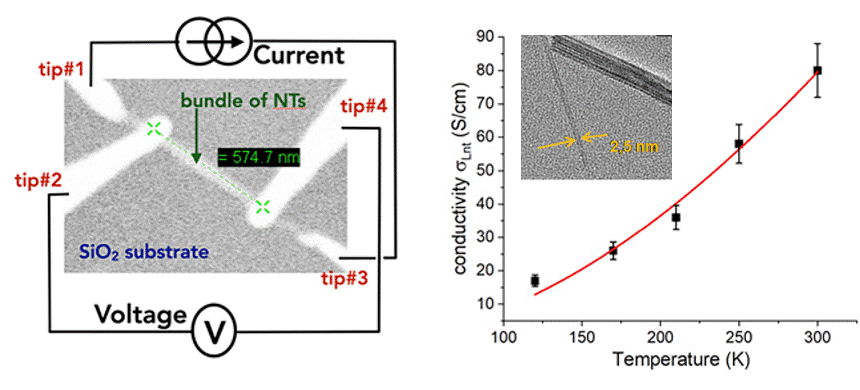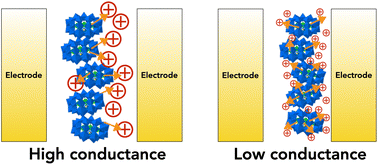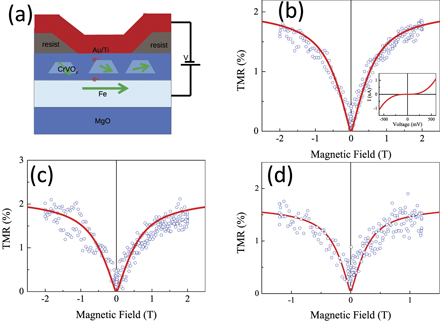publications, Réseau
Instability of Cobalt-Substituted Polyoxometalates during the Oxygen Evolution Reaction: An Operando X-ray Absorption Spectroscopy Study
Complexes of cobalt(II) stabilized by lacunary polyoxometalates (CoPOMs) are highly discussed water oxidation catalysts (WOC). While their activity and stability in the oxygen evolution reaction (OER) have been widely explored, there is still no consensus between those claiming that CoPOMs are active and stable OER catalysts and those suggesting that they rather act as precatalysts,… Read More
publications, Réseau
Electronic Properties of Electroactive Ferrocenyl-Functionalized MoS2
The attachment of redox-active molecules to transition metal dichalcogenides, such as MoS2, constitutes a promising approach for designing electrochemically switchable devices through the control of the material’s charge/spin transport properties by the redox state of the grafted molecule and thus the applied electrical potential. In this work, defective plasma-treated MoS2 is functionalized by a ferrocene… Read More
publications, Réseau
Elucidating the effect of spin crossover materials on graphene sensing devices
Graphene films are used to detect the presence and transition of spin crossover nanoparticle aggregates. Experiments performed far from the graphene neutrality point, combining impedance spectroscopy and Hall measurements, provide better insight into the mechanism for the change of impedance of the graphene layer in proximity with different states of the molecular structure. We observe… Read More
publications, Réseau
Highly conductive tungsten suboxide nanotubes
We demonstrate a high electron conductivity (>102 S/cm and up to 103 S/cm) of tungsten suboxide W18O52.4−52.9 (or equivalently WO2.91−2.94) nanotubes (2–3 nm in diameter, ∼μm long). The conductivity is measured in the temperature range of 120–300 K by a four-probe scanning tunneling microscope in ultrahigh vacuum. The nanotubes are synthesized by a low-temperature and low-cost solvothermal method. They… Read More
publications, Réseau
Experimental observation of the role of countercations in modulating the electrical conductance of Preyssler-type polyoxometalate nanodevices
Polyoxometalates are nanoscale molecular oxides with promising properties that are currently explored for molecule-based memory devices. In this work, we synthesize a series of Preyssler polyoxometalates (POMs), [Na⊂P5W30O110]14−, stabilized with four different counterions, H+, K+, NH4+, and tetrabutylammonium (TBA+). We study the electron transport properties at the nanoscale (conductive atomic force microscopy, C-AFM) of molecular… Read More
publications
Charge Transport Across Au–P3HT–Graphene van der Waals Vertical Heterostructures
Hybrid van der Waals heterostructures based on 2D materials and/or organic thin films are being evaluated as potential functional devices for a variety of applications. In this context, the graphene/organic semiconductor (Gr/OSC) heterostructure could represent the core element to build future vertical organic transistors based on two back-to-back Gr/OSC diodes sharing a common graphene sheet,… Read More
publications
X-ray magnetic dichroism and tunnel magneto-resistance study of the magnetic phase in epitaxial CrVOx nanoclusters
Epitaxial clusters of chromium and chromium–vanadium oxides are studied by tunnel magneto-resistivity measurements, x-ray absorption spectrometry and circular magnetic circular dichroism. They turn out to carry a small magnetic moment that follows a super-paramagnetic behavior. The chromium ion contribution to this magnetization is mainly due to an original magnetic Cr2O3-like phase, whereas usual Cr2O3 is… Read More
publications
When Identification of the Reduction Sites in Mixed Molybdenum/ Tungsten Keggin-Type Polyoxometalate Hybrids Turns Out Tricky
The mixed molybdenum/tungsten Keggin-type polyoxometalate (POM) hybrid (TBA)4[PW9Mo2O39{Sn(C6H4I)}] (TBA = tert-butylammonium) has been prepared by the reaction between [α-PW9Mo2O39]7– and [Cl3Sn(C6H4I)] in dried acetonitrile, in the presence of tetra-n-butylammonium bromide. A further coupling reaction affords the ferrocenyl derivative (TBA)4[PW9Mo2O39{Sn(C6H4)C≡C(C6H4)Fc}]. The POM hybrids have been thoroughly characterized by NMR and IR spectroscopies. Electrochemical analysis confirms their… Read More

